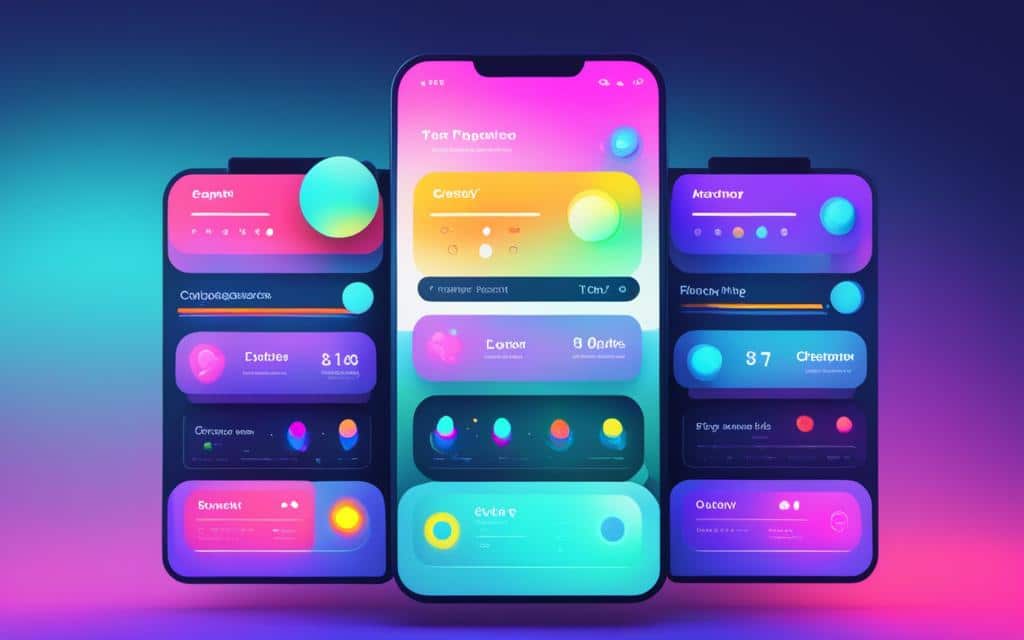Table of Contents
Colour is a critical component of interactive design, with a profound impact on user experience and engagement. Understanding colour theory and selecting the right colour schemes can enhance the aesthetic appeal of a design and effectively convey the intended message.
When it comes to interactive design, colour plays a crucial role in capturing attention, creating visual interest, and guiding users through their journey.
The colour wheel, developed by Sir Isaac Newton, provides a foundation for understanding colour relationships and helps designers create harmonious compositions. It categorises colours into primary, secondary, and intermediate colours, forming the basis for colour theory and selection.
By leveraging different colour schemes such as monochromatic, analogous, complementary, split-complementary, triadic, and tetradic, designers can achieve balance, contrast, and harmony in their designs.
Moreover, considering the colour temperature, which encompasses warm, cool, and neutral colours, allows designers to evoke specific emotions and resonate with users on a deeper level.
It is essential for designers to conduct user testing and research cultural connotations to ensure that the chosen colours align with user preferences and cultural backgrounds. This attention to detail contributes to an optimal user experience and effective communication of the design’s message.
In this article, we will explore the importance of colour in interactive design, delve into the science behind the colour wheel, discuss techniques for achieving harmony in colour selection, explore the impact of colour temperature, and delve into the influence of colour on mood and behaviour.
Join us on this journey as we uncover the fascinating world of colour in interactive design and discover how it can transform user experiences and captivate audiences.
The Importance of Color in Interactive Design
Color selection in interactive design is vital as it has a significant visual and psychological impact on users. Colors communicate the message behind the design and can reflect the niche and overall marketing strategy of a business. Choosing the right color scheme enhances aesthetic appeal, attracts users, and effectively conveys the intended message. By understanding color theory and utilizing different color schemes, designers can create visually appealing and engaging designs that resonate with the target audience.
The Visual and Psychological Impact of Color Selection
The visual impact of color in interactive design cannot be understated. Colors have the power to evoke emotions, capture attention, and influence user behavior. Vibrant and bold colors may create a sense of excitement and energy, while muted or pastel shades can evoke a calming and peaceful atmosphere. By carefully selecting colors, designers can shape the visual experience and guide users through their journey on a website or application.
“Color is a power that directly influences the soul.” – Wassily Kandinsky
Beyond the visual impact, color also has a psychological impact on users. Different colors are associated with specific emotions and cultural connotations. For example, blue is often associated with trust and reliability, while red can evoke feelings of urgency or passion. By understanding these associations and considering the target audience’s preferences and cultural backgrounds, designers can use color to establish a connection and create a more immersive interactive experience.
Reflecting the Niche and Marketing Strategy
In addition to its visual and psychological impact, color selection in interactive design can reflect the niche and overall marketing strategy of a business. Colors can convey specific brand personalities, values, and messages. For example, a website or app catering to a luxury audience may use gold or royal purple tones to represent opulence and exclusivity. On the other hand, a brand focused on eco-friendliness and sustainability might opt for earthy tones and shades of green to reflect their values.
Creating Visual Appeal and Engaging Experiences
The color scheme chosen for an interactive design significantly contributes to its overall aesthetic appeal. A well-balanced and harmonious use of colors can captivate users, encourage engagement, and leave a lasting impression. By utilizing color theory and exploring different color schemes, designers can create visually engaging experiences that resonate with the target audience and effectively convey the intended message.
To further illustrate the importance of color in interactive design, consider the following table showcasing the psychological associations and potential brand messages conveyed by different colors:
| Color | Psychological Associations | Potential Brand Messages |
|---|---|---|
| Red | Passion, urgency, excitement | Bold, powerful, energetic |
| Blue | Trust, reliability, calmness | Professional, trustworthy, peaceful |
| Green | Growth, harmony, eco-friendliness | Sustainable, natural, fresh |
| Yellow | Optimism, positivity, attention-grabbing | Cheerful, vibrant, innovative |
By considering the psychological associations and potential brand messages, designers can strategically select colors that align with the goals and values of the interactive design.
In conclusion, the importance of color in interactive design cannot be overstated. From its visual and psychological impact to its reflection of niche and marketing strategy, color selection plays a crucial role in creating visually appealing and engaging experiences. By understanding color theory, considering user preferences and cultural connotations, and utilizing different color schemes, designers can optimize the user experience and effectively communicate the intended message.
Understanding the Color Wheel
The color wheel is a fundamental tool in interactive design that illustrates the relationships between different colors. It categorizes colors into primary, secondary, and intermediate colors, providing a framework for color choices and creating harmonious designs.
Primary colors, including yellow, red, and blue, are the building blocks of all other colors. These colors cannot be broken down into simpler colors and serve as a foundation for color mixing.
Secondary colors, such as orange, green, and purple, are created by combining two primary colors. Mixing yellow and red creates orange, red and blue create purple, and yellow and blue create green. Secondary colors add vibrancy and variety to color schemes.
Intermediate or tertiary colors are hybrids formed by mixing primary and secondary colors. These colors, including chartreuse, turquoise, and magenta, offer even more possibilities for designers to explore and incorporate into their designs.
The color wheel allows designers to visualize the relationships and interactions between different colors, enabling them to make informed color choices. By understanding how primary, secondary, and intermediate colors relate to each other, designers can create balanced and visually appealing designs that capture the attention and engage users.
Color Wheel Representation:
| Primary Colors | Secondary Colors | Intermediate Colors |
|---|---|---|
| Yellow | Orange | Chartreuse |
| Red | Green | Turquoise |
| Blue | Purple | Magenta |
By referring to the color wheel, designers can confidently choose colors that harmonize with the desired color scheme and achieve a cohesive and visually pleasing design.
The color wheel provides a solid foundation for understanding color relationships and guides designers in creating visually captivating and harmonious interactive designs.
Achieving Harmony in Color Selection
When it comes to interactive design, color selection plays a pivotal role in achieving harmony and enhancing the overall aesthetic appeal of a design. Choosing the right color scheme can significantly impact the user experience and create visually appealing designs that resonate with the target audience.
There are various color schemes to consider, each with its own unique characteristics and effects on the user experience. Let’s explore some of the most popular color schemes:
- Monochromatic schemes: These schemes are based on shades and tones of a single hue. By utilizing variations within a single color, designers can create a minimalistic and less distracting layout.
- Analogous color schemes: These schemes involve using three colors that are next to each other on the color wheel. This combination creates a natural and harmonious feel, making it an ideal choice for designs seeking a more relaxed and cohesive aesthetic.
- Complementary schemes: Complementary colors are opposite each other on the color wheel. This scheme creates a high contrast and vibrant effect, making elements pop out and catch the user’s attention.
- Split-complementary schemes: This scheme combines complementary and analogous colors. By using one dominant color alongside two colors adjacent to its complement, designers achieve a softer impact that maintains harmony while offering a broader range of hues.
- Triadic schemes: Triadic color schemes utilize three colors equally spaced on the color wheel. This combination creates vibrant and visually contrasting designs, allowing each color to stand out while maintaining a balanced composition.
- Tetradic schemes: This scheme involves using four colors that are evenly spaced on the color wheel. Tetradic schemes offer a wide range of color combinations, but they require careful balance to avoid overwhelming the design.
By carefully considering these color schemes, designers can achieve harmony in color selection, resulting in visually appealing designs that enhance the overall user experience.
When incorporating color schemes, it’s important to remember that color temperature, which includes warm, cool, and neutral colors, can also impact the overall aesthetic and user experience. The selection of warm colors, such as reds and oranges, can create a passionate and energetic ambiance, while cool colors like blues and greens tend to evoke calming and soothing sensations. Neutral colors, such as grays and browns, provide a balanced backdrop to other color choices.
Let’s take a moment to visually appreciate the beauty and impact of effectively chosen color schemes:
| Color Scheme | Characteristics | User Experience |
|---|---|---|
| Monochromatic | Minimalistic and less distracting | Creates a harmonious and calm experience |
| Analogous | Natural and harmonious | Elicits a sense of cohesiveness and comfort |
| Complementary | High contrast and vibrant | Grabs attention and creates visual impact |
| Split-complementary | Soft impact and broader range of hues | Combines harmony and variety |
| Triadic | Vibrant and visually contrasting | Creates a dynamic and energetic experience |
| Tetradic | Wide range of color combinations | Requires careful balance for a cohesive design |
By understanding the characteristics and effects of different color schemes, designers can make informed decisions to create visually appealing designs that enhance the overall aesthetic and user experience. The careful selection and implementation of color schemes contribute to creating harmonious, engaging, and visually captivating designs.
The Importance of Color Temperature
Color temperature is an essential consideration in interactive design as it has a significant impact on the overall mood and emotional response of a design. By understanding the emotional associations of warm, cool, and neutral colors, designers can create designs that effectively resonate with users.
Warm Colors
Warm colors, such as red, orange, and yellow, are associated with passion, energy, and happiness. These vibrant hues evoke a sense of warmth and excitement, making them ideal for designs that aim to create a strong emotional impact. Whether it’s a call-to-action button or a bold headline, incorporating warm colors can draw users’ attention and stimulate their enthusiasm.
Cool Colors
Cool colors, including blue, green, and purple, have a calming and soothing effect on viewers. These colors evoke tranquility, relaxation, and a sense of serenity. Cool colors are often used in designs where creating a peaceful atmosphere and conveying a sense of trust is important, such as healthcare websites or meditation apps.
Neutral Colors
Neutral colors like gray, brown, white, and black do not convey specific emotions on their own. However, they play a crucial role in balancing and complementing other colors in a design. Neutral colors can enhance the visual appeal and readability of content by providing a clean and unobtrusive backdrop. They are often used for backgrounds, text, and other elements that require a subtle presence.
When selecting color schemes, designers should consider color temperature in conjunction with other design elements to create designs that evoke the desired emotional responses, draw attention to key elements, and provide an engaging user experience.
The Influence of Color on Mood and Behavior
Color plays a crucial role in interactive design, not only in terms of aesthetics but also in its ability to elicit specific emotions and influence user behavior. Through the field of color psychology, designers can harness the power of color to create immersive and impactful experiences for users.
One aspect that affects individuals’ reactions to color is their personal associations. Colors can evoke memories and experiences, triggering different emotional responses in each individual. For example, someone who associates the color blue with tranquility and peacefulness may feel a sense of calm when encountering blue elements in a design. By understanding and tapping into these personal associations, designers can create designs that resonate with their target audience on a deeper level.
Cultural differences also influence color associations. Different cultures have varying interpretations and connotations of colors. For instance, while white symbolizes purity and innocence in many Western cultures, it represents mourning and grief in some Eastern cultures. Designers must consider these cultural nuances to avoid misinterpretation or causing offense. By conducting thorough research on cultural color symbolism, designers can ensure their designs effectively communicate across cultural boundaries.
“Colors can be universally understood or culturally specific, with a psychological impact that transcends language barriers.” – Color Psychology Expert
Research has also shown that colors can have tangible effects on performance. Different colors stimulate different cognitive abilities and behaviors. For instance, studies have found that exposure to the color red can enhance attention to detail and improve performance in tasks requiring precision, while blue has calming effects, promoting relaxation and focus. By strategically incorporating colors that align with desired outcomes, designers can optimize user performance and promote desired user behaviors.
The influence of color on mood and behavior underscores the importance of carefully selecting and utilizing colors in interactive design. By leveraging color psychology, considering personal associations and cultural differences, and understanding the performance effects of colors, designers can create user-centric designs that captivate and engage users, ultimately enhancing the overall user experience.
| Color | Emotional Association |
|---|---|
| Red | Passion, energy, urgency |
| Blue | Calmness, trust, serenity |
| Green | Freshness, growth, harmony |
| Yellow | Happiness, optimism, warmth |
| Orange | Creativity, enthusiasm, vitality |
Conclusion
Color has a profound impact on the user experience in interactive design. By utilizing color theory and understanding different color schemes, designers can create visually appealing and engaging designs that leave a lasting impression. The careful consideration of color temperature and the psychological effects of color also play a crucial role in evoking specific emotions and resonating with users.
Designers should conduct user testing and research cultural connotations to ensure that the chosen colors align with users’ preferences and cultural backgrounds. By taking into account individual and cultural associations with color, designers can effectively convey the intended message and optimize the user experience. Through thoughtful design considerations and a deep understanding of color’s impact, designers can create designs that not only captivate users visually but also enhance their overall experience.
Ultimately, color selection is a crucial aspect of interactive design, influencing user engagement and creating aesthetic appeal. By applying color theory, considering color temperature, and understanding the psychological effects of color, designers can harness the power of color to create designs that resonate with users and deliver a memorable user experience.
FAQ
How does color impact user experience in interactive design?
Color plays a crucial role in interactive design, impacting the user experience and engagement. Understanding color theory and choosing the right color schemes can enhance the aesthetic appeal of a design and effectively communicate the intended message.
What is the importance of color selection in interactive design?
Color selection in interactive design is vital as it has a significant visual and psychological impact on users. Colors communicate the message behind the design and can reflect the niche and overall marketing strategy of a business.
What is the color wheel and how does it categorize colors?
The color wheel, developed by Sir Isaac Newton, categorizes colors into primary, secondary, and intermediate colors. Primary colors are basic colors that cannot be broken down into simpler colors. Secondary colors are created by mixing two primary colors, and intermediate colors are hybrids formed by mixing primary and secondary colors.
How can designers achieve harmony in color selection?
Designers can achieve harmony in their designs by utilizing different color schemes such as monochromatic, analogous, complementary, split-complementary, triadic, and tetradic. By considering these color schemes, designers can create visually appealing and engaging designs.
What is the importance of color temperature in interactive design?
Color temperature, which includes warm, cool, and neutral colors, is an essential consideration in interactive design, as it can evoke specific emotions and impact the overall mood of a design. Designers should consider color temperature in conjunction with color schemes to create designs that resonate with users and evoke the desired emotional responses.
How does color influence mood and behavior in interactive design?
Color psychology is a significant aspect of interactive design, as different colors can elicit specific emotions and influence user behavior. Personal associations with colors and cultural differences also play a role in color associations. Additionally, research suggests that colors can impact performance, with different colors affecting cognitive abilities and behavior.
What should designers consider when choosing colors for interactive design?
Designers should conduct user testing, research cultural connotations, and consider individual and cultural associations with color to ensure that the chosen colors resonate with users and effectively convey the intended message. Careful consideration and understanding of color’s impact can optimize the user experience and create designs that leave a lasting impression.













